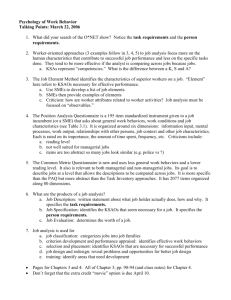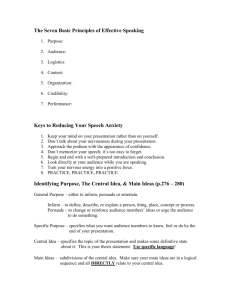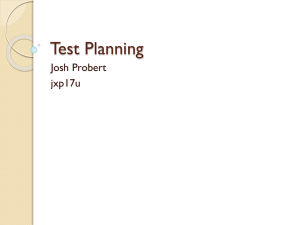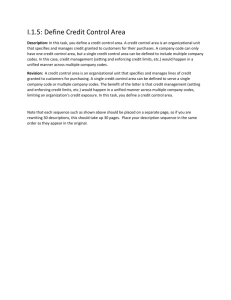3a. Standard for Software Test Documentation (IEEE829) (addendum)
advertisement
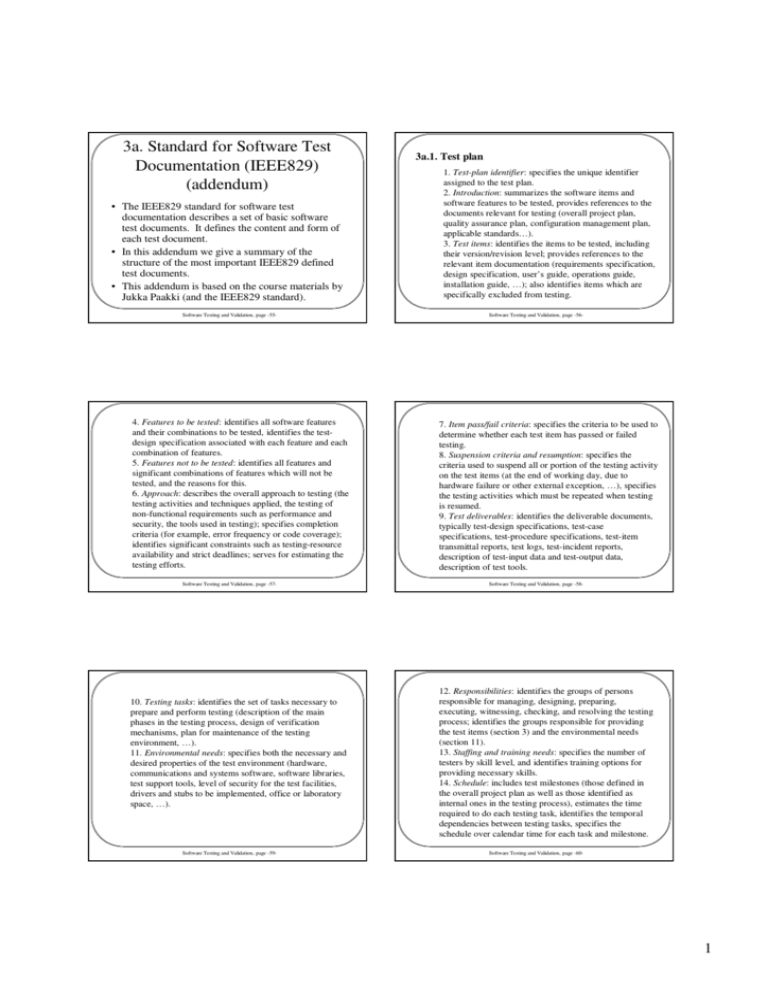
3a. Standard for Software Test Documentation (IEEE829) (addendum) • The IEEE829 standard for software test documentation describes a set of basic software test documents. It defines the content and form of each test document. • In this addendum we give a summary of the structure of the most important IEEE829 defined test documents. • This addendum is based on the course materials by Jukka Paakki (and the IEEE829 standard). Software Testing and Validation, page -55- 4. Features to be tested: identifies all software features and their combinations to be tested, identifies the testdesign specification associated with each feature and each combination of features. 5. Features not to be tested: identifies all features and significant combinations of features which will not be tested, and the reasons for this. 6. Approach: describes the overall approach to testing (the testing activities and techniques applied, the testing of non-functional requirements such as performance and security, the tools used in testing); specifies completion criteria (for example, error frequency or code coverage); identifies significant constraints such as testing-resource availability and strict deadlines; serves for estimating the testing efforts. Software Testing and Validation, page -57- 10. Testing tasks: identifies the set of tasks necessary to prepare and perform testing (description of the main phases in the testing process, design of verification mechanisms, plan for maintenance of the testing environment, …). 11. Environmental needs: specifies both the necessary and desired properties of the test environment (hardware, communications and systems software, software libraries, test support tools, level of security for the test facilities, drivers and stubs to be implemented, office or laboratory space, …). Software Testing and Validation, page -59- 3a.1. Test plan 1. Test-plan identifier: specifies the unique identifier assigned to the test plan. 2. Introduction: summarizes the software items and software features to be tested, provides references to the documents relevant for testing (overall project plan, quality assurance plan, configuration management plan, applicable standards…). 3. Test items: identifies the items to be tested, including their version/revision level; provides references to the relevant item documentation (requirements specification, design specification, user’s guide, operations guide, installation guide, …); also identifies items which are specifically excluded from testing. Software Testing and Validation, page -56- 7. Item pass/fail criteria: specifies the criteria to be used to determine whether each test item has passed or failed testing. 8. Suspension criteria and resumption: specifies the criteria used to suspend all or portion of the testing activity on the test items (at the end of working day, due to hardware failure or other external exception, …), specifies the testing activities which must be repeated when testing is resumed. 9. Test deliverables: identifies the deliverable documents, typically test-design specifications, test-case specifications, test-procedure specifications, test-item transmittal reports, test logs, test-incident reports, description of test-input data and test-output data, description of test tools. Software Testing and Validation, page -58- 12. Responsibilities: identifies the groups of persons responsible for managing, designing, preparing, executing, witnessing, checking, and resolving the testing process; identifies the groups responsible for providing the test items (section 3) and the environmental needs (section 11). 13. Staffing and training needs: specifies the number of testers by skill level, and identifies training options for providing necessary skills. 14. Schedule: includes test milestones (those defined in the overall project plan as well as those identified as internal ones in the testing process), estimates the time required to do each testing task, identifies the temporal dependencies between testing tasks, specifies the schedule over calendar time for each task and milestone. Software Testing and Validation, page -60- 1 3a.2. Test-case specification 15. Risks and contingencies: identifies the high-risk assumptions of the test plan (lack of skilled personnel, possible technical problems, …), specifies contingency plans for each risk (employment of additional testers, increase of night shift, exclusion of some tests of minor importance, …). 16. Approvals: specifies the persons who must approve this plan. Software Testing and Validation, page -61- 4. Output specifications: specifies all of the outputs and features (for example, response time) required of the test items, provides the exact value (with tolerances where appropriate) for each required output or feature. 5. Environmental needs: specifies the hardware and software configuration needed to execute this test case, as well as other requirements (such as specially trained operators or testers). 6. Special procedural requirements: describes any special constraints on the test procedures which execute this test case (special set-up, operator intervention, …). 7. Intercase dependencies: lists the identifiers of test cases which must be executed prior to this test case, describes the nature of the dependencies. Software Testing and Validation, page -63- 3. Bug description: provides a description of the incident, so as to correct the bug, repeat the incident or analyze it off-line: • Inputs. • Expected results. • Actual results. • Date and time. • Test-procedure step. • Environment. • Repeatability (whether repeated; whether occurring always, occasionally or just once). • Testers. • Other observers. • Additional information that may help to isolate and correct the cause of the incident; for example, the sequence of operational steps or history of user-interface commands that lead to the (bug) incident. 4. Impact: Priority of solving the incident / correcting the bug (urgent, high, medium, low). Software Testing and Validation, page -65- 1. Test-case-specification identifier: specifies the unique identifier assigned to this test-case specification. 2. Test items: identifies and briefly describes the items and features to be exercised by this test case, supplies references to the relevant item documentation (requirements specification, design specification, user’s guide, operations guide, installation guide, …). 3. Input specifications: specifies each input required to execute the test case (by value with tolerances or by name); identifies all appropriate databases, files, terminal messages, memory resident areas, and external values passed by the operating system; specifies all required relationships between inputs (for example, timing). Software Testing and Validation, page -62- 3a.3. Test-incident report (bug report) 1. Bug-report identifier: specifies the unique identifier assigned to this report. 2. Summary: summarizes the (bug) incident by identifying the test items involved (with version/revision level) and by referencing the relevant documents (testprocedure specification, test-case specification, test log). Software Testing and Validation, page -64- 3a.4. Test-summary report 1 Test-summary-report identifier: specifies the unique identifier assigned to this report. 2. Summary: summarizes the evaluation of the test items, identifies the items tested (including their version/revision level), indicates the environment in which the testing activities took place, supplies references to the documentation over the testing process (test plan, test-design specifications, test-procedure specifications, test-item transmittal reports, test logs, test-incident reports, …). Software Testing and Validation, page -66- 2 3. Variances: reports any variances/deviations of the test items from their design specifications, indicates any variances of the actual testing process from the test plan or test procedures, specifies the reason for each variance. 4. Comprehensiveness assessment: evaluates the comprehensiveness of the actual testing process against the criteria specified in the test plan, identifies features or feature combinations which were not sufficiently tested and explains the reasons for omission. 5. Summary of results: summarizes the success of testing (such as coverage), identifies all resolved and unresolved incidents. Software Testing and Validation, page -67- 3a.5. Inspection checklist for test plans: 1. Have all materials required for a test plan inspection been received? 2. Are all materials in the proper physical format? 3. Have all test plan standards been followed? 4. Has the testing environment been completely specified? 5. Have all resources been considered, both human and hardware/software? 6. Have all testing dependencies been addressed (driver function, hardware, etc.)? 7. Is the test plan complete, i.e., does it verify all of the requirements? (For unit testing: does the plan test all functional and structural variations from the high-level and detailed design?) 8. Is each script detailed and specific enough to provide the basis for test case generation? 9. Are all test entrance and exit criteria sufficient and realistic? Software Testing and Validation, page -69- 3a.6. Inspection checklist for test cases: 1. Have all materials required for a test case inspection been received? 2. Are all materials in the proper physical format? 3. Have all test case standards been followed? 4. Are the functional variations exercised by each test case required by the test plan? (Relevant for unit test case documents only.) 5. Are the functional variations exercised by each test case clearly documented in the test case description? (Relevant for unit test case documents only.) 6. Does each test case include a complete description of the expected input, and output or result? 7. Have all testing execution procedures been defined and documented? 8. Have all testing dependencies been addressed (driver function, hardware, etc.)? 9. Do the test cases accurately implement the test plan? Software Testing and Validation, page -71- 6. Evaluation: provides an overall evaluation of each test item including its limitations (based upon the test results and the item-level pass/fail criteria). 7. Summary of activities: summarizes the major testing activities and events, summarizes resource consumption (total staffing level, total person-hours, total machine time, total elapsed time used for each of the major testing activities, …). 8. Approvals: specifies the persons who must approve this report (and the whole testing phase). Software Testing and Validation, page -68- 10. Are invalid as well as valid input conditions tested? 11. Have all pass/fail criteria been defined? 12. Does the test plan outline the levels of acceptability for pass/fail and exit criteria (e.g., defect tolerance)? 13. Have all suspension criteria and resumption requirements been identified? 14. Are all items excluded from testing documented as such? 15. Have all test deliverables been defined? 16. Will software development changes invalidate the plan? (Relevant for unit test plans only.) 17. Is the intent of the test plan to show the presence of failures and not merely the absence of failures? 18. Is the test plan complete, correct, and unambiguous? 19. Are there holes in the plan; is there overlap in the plan? 20. Does the test plan offer a measure of test completeness and test reliability to be sought? 21. Are the test strategy and philosophy feasible? Software Testing and Validation, page -70- 10. Are all data set definitions and setup requirements complete and accurate? 11. Are operator instructions and status indicators complete, accurate, and simple? 12. Have all intercase dependencies been identified and described? 13. Is each condition tested once and only once? 14. Have all test entrance and exit criteria been observed? 15. Are the test cases designed to show the presence of failure and not merely the absence of failure? 16. Are the test cases designed to show omissions and extensions? 17. Are the test cases complete, correct, and unambiguous? 18. Are the test cases realistic? 19. Are the test cases documented so as to be 100 percent reproducible? 20. Has the entire testing environment been documented? 21. Has configuration management been setup, directories established, and have case data and tools been loaded? Software Testing and Validation, page -72- 3

